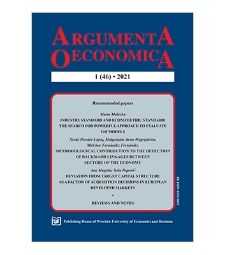Object
Title: Methodological contribution to the detection of backward linkages between sectors of the economy
Creator:
López, Xesús Pereira ; Węgrzyńska, Małgorzata Anna ; Fernández, Melchor Fernández
Description:
Argumenta Oeconomica, 2021, Nr 1 (46), s. 31-52
Abstrakt:
Publisher:
Publishing House of Wroclaw University of Economics and Business
Place of publication:
Date:
Resource Type:
Resource Identifier:
doi:10.15611/aoe.2021.1.02 ; oai:dbc.wroc.pl:110253
Language:
Relation:
Argumenta Oeconomica, 2021, Nr 1 (46)
Rights:
Pewne prawa zastrzeżone na rzecz Autorów i Wydawcy
Access Rights:
Dla wszystkich zgodnie z licencją
License:
CC BY-SA 4.0
Location:
Group publication title:
Object collections:
- Lower Silesian Digital Library > Participants of the Consortium > 04. Wroclaw University of Economics > Periodicals published by the University Publishing House > Argumenta Oeconomica
- Lower Silesian Digital Library > Resources > 2. Czasopisma > Czasopisma współczesne
Last modified:
Apr 17, 2024
In our library since:
May 31, 2021
Number of object content hits:
424
All available object's versions:
https://dbc.wroc.pl/publication/152468
Show description in RDF format:
Show description in OAI-PMH format:
| Edition name | Date |
|---|---|
| Methodological contribution to the detection of backward linkages between sectors of the economy | Apr 17, 2024 |
Similar
Węgrzyńska, Małgorzata Anna
Węgrzyńska, Małgorzata Anna
























